Physical Address
304 North Cardinal St.
Dorchester Center, MA 02124
Physical Address
304 North Cardinal St.
Dorchester Center, MA 02124
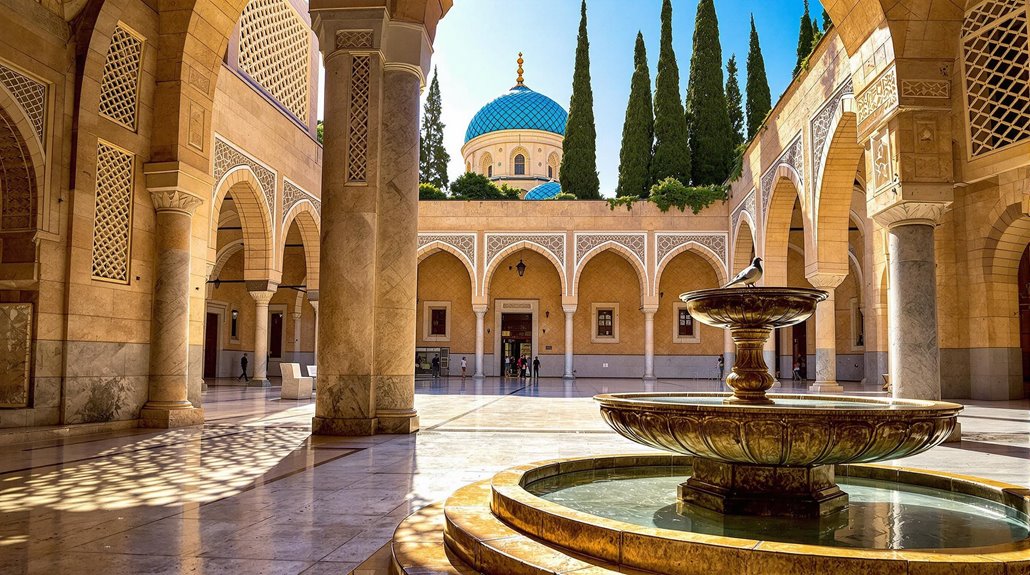
Syria's ancient wonders, from the majestic ruins of Palmyra to the winding streets of Damascus's Old Town, offer you a journey through 5,000 years of human civilization. You'll discover perfectly preserved Crusader castles, intricate Roman theaters, and bustling traditional souqs filled with artisanal crafts. The country's rich cultural heritage shines through its UNESCO sites, traditional cuisine, and resilient local communities. Let's explore the 15 compelling reasons that make Syria an extraordinary destination.
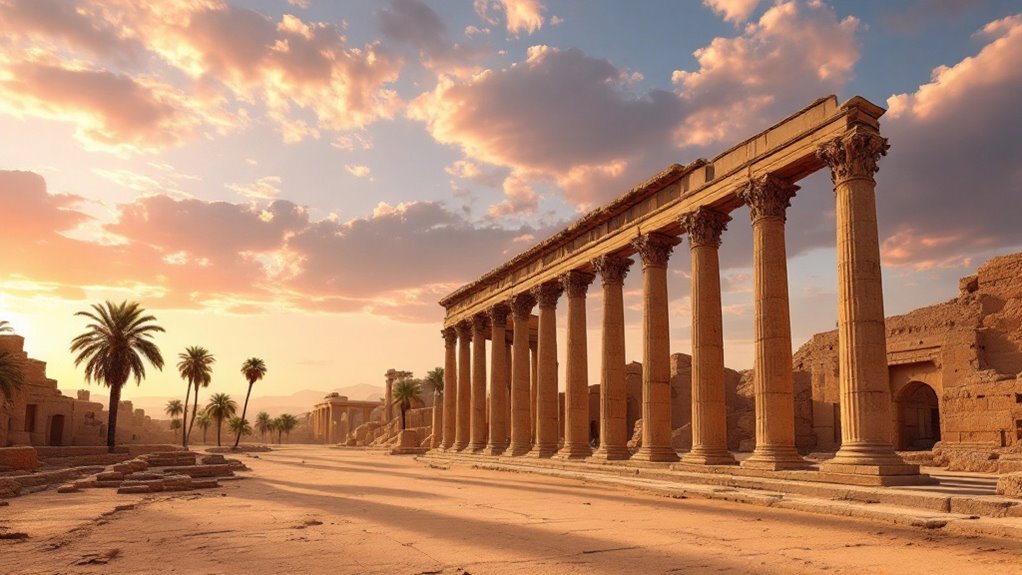
While many ancient Roman sites dot the Mediterranean coast, none can match the mystical allure of Palmyra, a UNESCO World Heritage Site rising from Syria's desert landscape.
You'll be transported back to the height of Roman-era trade as you walk the 1,100-meter Grand Colonnade, where silk-laden caravans once passed beneath towering Corinthian columns.
The site showcases an extraordinary fusion of cultures, from the Temple of Bel's blend of Near Eastern and Greco-Roman architecture to the bilingual inscriptions in Palmyrene Aramaic and Greek.
Palmyra stands as a testament to cultural convergence, where ancient Near Eastern and Classical traditions merge in magnificent architectural harmony.
Despite recent conflicts, over half the ruins remain intact, including the impressive Agora and the Camp of Diocletian's walls.
You can now join guided tours that highlight both the site's historical significance and its remarkable resilience through the centuries.
The city's strategic location at the intersection of two major trade routes made it a crucial hub for commerce between the Roman Empire and regions as far as India and China.
A tribute to human resilience, the Aleppo Citadel stands majestically atop a 50-meter limestone hill, commanding attention as one of the world's oldest and largest fortified castles.
You'll marvel at its elliptical base spanning 450 by 325 meters, where ancient civilizations from Hittites to Ottomans have left their mark. The site was home to an ancient temple of Storm God Hadad during the third millennium BC. As you cross the deep moat and enter through the fortified entrance, you'll discover a fascinating blend of military and residential structures, including the grand Throne Hall and Ibrahim shrine.
While recent conflicts and earthquakes have tested its strength, the citadel's ongoing restoration means you can now explore its restored ramparts and walkways.
Don't miss the archaeological treasures within, from Roman mosaics to Neo-Hittite inscriptions, all evidence of Syria's rich cultural heritage.
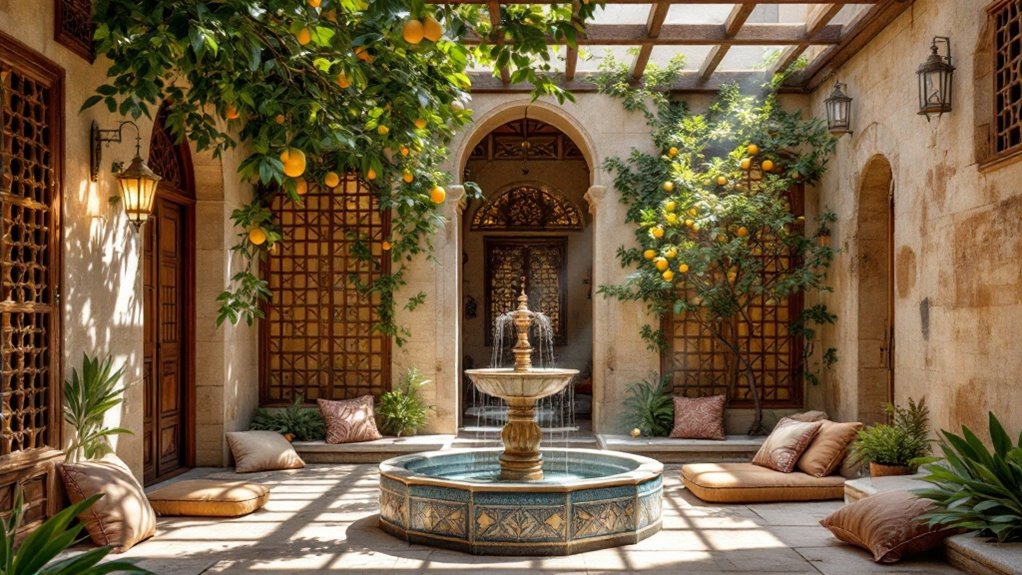
Beyond the bustling streets of Damascus's Old Town lie hidden architectural gems that you'll discover through ornate wooden doors: the city's enchanting courtyard houses.
These masterpieces of traditional Syrian architecture showcase a perfect blend of Islamic, Ottoman, and Persian styles, with thick basalt walls concealing lush gardens and intricate designs within. One prime example is the Maktab Anbar palace, which showcases the luxurious lifestyle of 19th-century Damascene elite.
Step inside these historic havens to find:
You'll marvel at the expert craftsmanship in these living museums, where damascene families have preserved centuries-old traditions.
Many courtyard houses now serve as boutique hotels and cultural centers, offering visitors an authentic glimpse into Syria's architectural heritage.
Perched atop a 650-meter hilltop overlooking the strategic Homs Gap, Krak des Chevaliers stands as the world's most impressive and well-preserved Crusader fortress.
Originally built for the Emir of Aleppo in 1031 AD, this magnificent stronghold has witnessed centuries of military history.
You'll encounter this UNESCO World Heritage site that combines Romanesque, Gothic, Byzantine, and Islamic architectural styles throughout its massive structure, where walls reach up to 30 meters high and 6 meters thick.
While exploring the labyrinthine halls, you'll uncover ingenious medieval defensive features, including arrow slits, murder holes, and a rock-cut moat.
Medieval ingenuity reveals itself through deadly architectural features: arrow slits, murder holes, and a formidable rock-cut moat.
You can access the castle via a 45-minute drive from Homs or 1 hour and 40 minutes from Tripoli, and you'll be treated to panoramic valley views from the fortified walls.
Despite recent conflict damage, the castle's chapels, courtyards, and cisterns remain largely intact, offering you an unparalleled glimpse into Crusader military architecture.

The majestic Al-Hamidiyah Souq, Damascus's largest covered market, stands as a living tribute to Syria's rich artisanal heritage since 1780.
As you walk beneath its 10-meter-tall iron arch roof, you'll discover a treasure trove of traditional Syrian craftsmanship spanning 600 meters of market space.
You'll find expert artisans crafting three distinctive specialties:
The souq is also home to talented mosaic artisans who create breathtaking glass designs depicting nature and historical scenes.
Don't miss the specialized sections, where you can browse through the spice-filled corridors of Souk al-Buzuriyah or explore precious metals at Souk al-Saghah, where gold merchants showcase their finest pieces.
While Damascus's bustling souq showcases Syria's living traditions, Northwestern Syria holds an even more ancient treasure – a remarkable collection of 40+ Byzantine-era villages that stand frozen in time.
You'll discover a fascinating shift from Roman paganism to early Christianity as you explore these UNESCO World Heritage Sites, where well-preserved churches, monasteries, and dwellings date back to the 1st-7th centuries CE.
Don't miss the hidden underground churches with escape tunnels in Manbij, or the rock-cut St. Thecla Convent carved into cliffs.
At Ma'aloula village, you can hear locals still speaking Aramaic, the language of Jesus, while the impressive St. George Monastery reveals layers of history through its 6th, 12th, and 16th-century architecture.
These villages offer an unparalleled glimpse into rural Byzantine life, complete with ancient hydraulic systems and agricultural terraces.
Recent asphalted roads have made these archaeological parks more accessible to visitors than ever before.
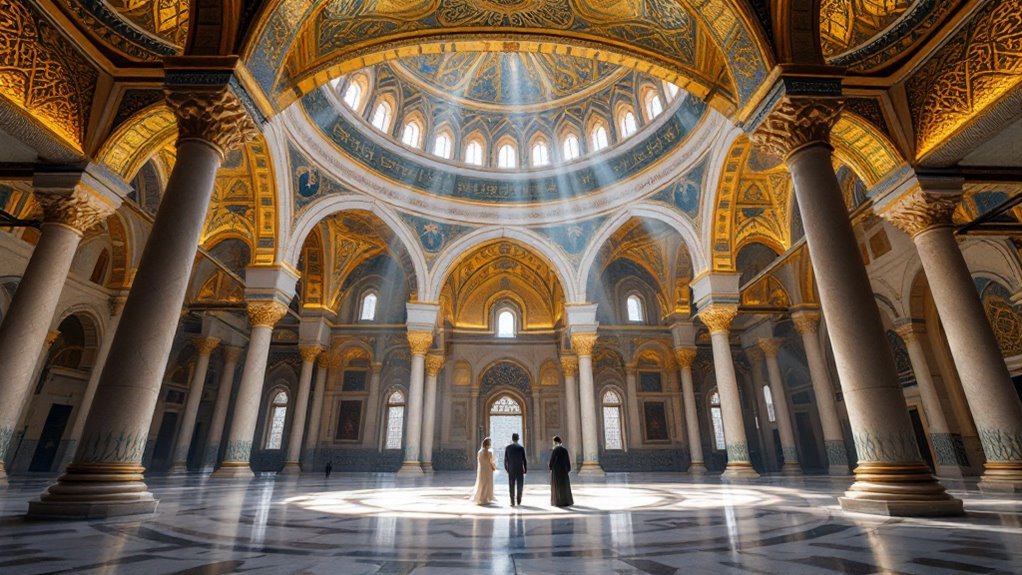
Standing majestically in Damascus's historic heart, the Umayyad Mosque represents one of Islam's most significant architectural achievements, where you'll discover a fascinating blend of religious heritage spanning three faiths.
The construction employed 12,000 skilled workers to create this masterpiece, transforming the existing cathedral into an architectural marvel.
As you explore, you'll be amazed by the stunning gold mosaics, towering arcades, and the impressive Dome of the Eagle rising 36 meters high.
Three remarkable features you shouldn't miss:
You'll walk the same grounds where worship has continued uninterrupted since the Iron Age, experiencing a living embodiment of Syria's rich religious history.
Built during the second century CE, Syria's magnificent Roman Theatre at Bosra stands as one of antiquity's most remarkable engineering achievements, where you'll discover an extraordinary structure carved entirely from local black basalt stone.
You'll be amazed by its near-perfect acoustics and innovative design, which accommodated up to 17,000 spectators through efficient vomitoria passageways. Unlike many Roman theaters, this architectural marvel was built freestanding without relying on natural hillsides.
Its durability is a proof of Roman engineering, having survived earthquakes and warfare thanks to its sturdy basalt construction and later fortification as an Ayyubid citadel. The theatre's remarkable preservation can be attributed to the sand accumulation protection of its interior over centuries.
While visiting, you can explore the 45-meter-long stage, admire the decorative pillars, and witness the seamless blend of Roman, Byzantine, and Islamic architectural elements.
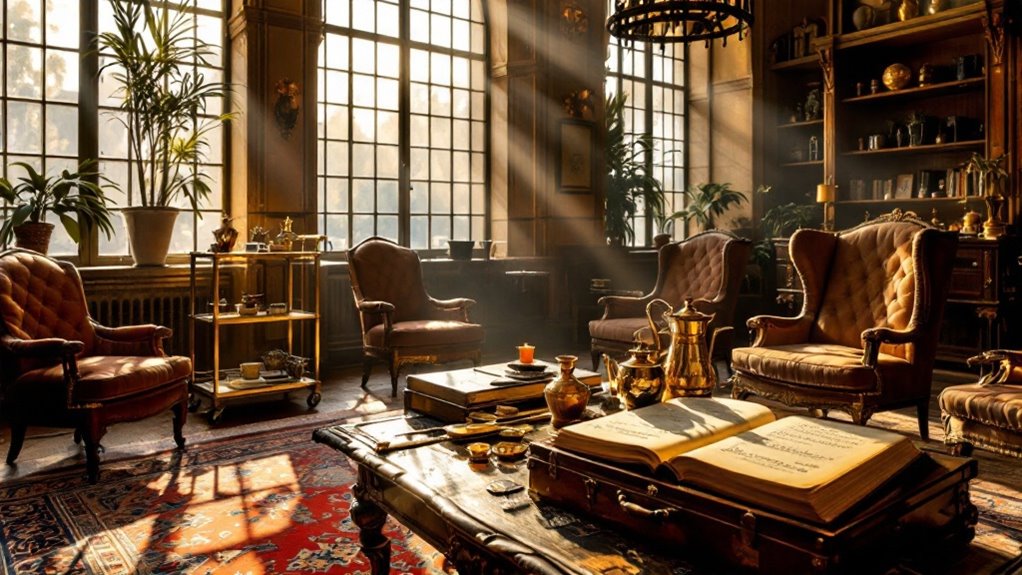
Since its grand opening in 1911, Aleppo's Baron Hotel has welcomed the world's most illustrious guests, from Lawrence of Arabia to Agatha Christie, within its storied walls.
You'll discover yourself walking in the footsteps of history, where Room 215's balcony witnessed King Faisal I's declaration of Syrian independence, and where Christie penned her famous "Murder on the Orient Express."
The Baron Hotel expanded its legacy over time, with the addition of a third floor in 1940.
The hotel's abundant legacy includes:
Though currently closed due to Syria's ongoing crisis, the Baron Hotel stands as a symbol of Syria's golden age of international travel and diplomacy.
A centuries-old legacy of handcrafted excellence lives on in Aleppo's celebrated soap-making tradition, where artisans still produce what's considered one of the world's oldest continuously manufactured soaps.
You'll discover this UNESCO-recognized heritage at the city's historic factories, where you can watch skilled craftsmen blend olive and laurel oils using time-honored hot-process methods.
During your visit, you'll see how the iconic green soap is poured, cut, stamped, and aged for up to a year underground.
Don't miss the chance to purchase authentic bars directly from workshops or vendors in the reconstructed Al-Madina Souk.
While some facilities are still rebuilding after recent conflicts, many have resumed production, offering you a glimpse into this enduring symbol of Syrian craftsmanship. The 2019 factory reopening marked a triumphant return to traditional soap-making after seven years of wartime closure.
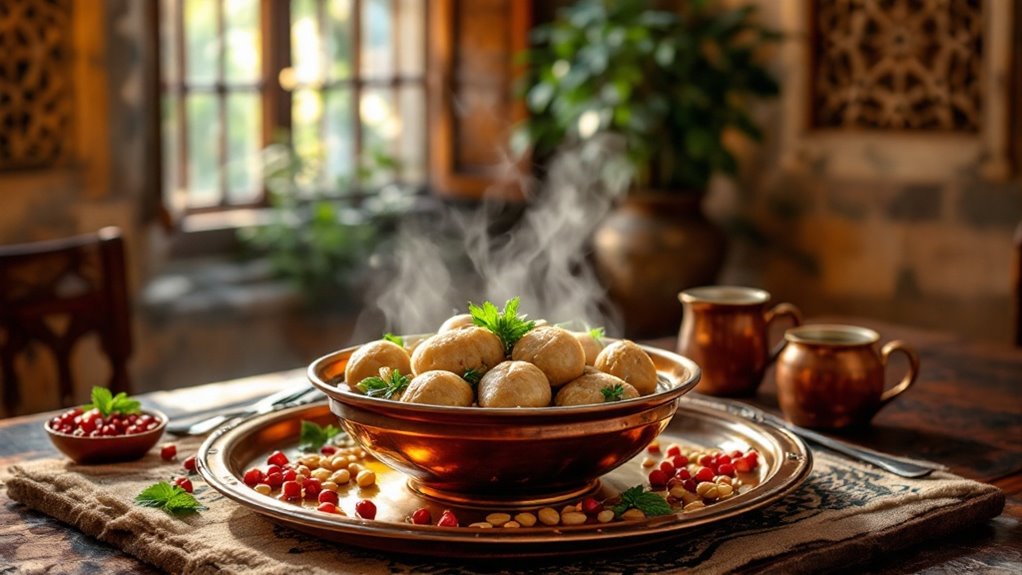
Throughout centuries of trade along the legendary Silk Road, Syria's cuisine has evolved into a magnificent tapestry of flavors, spices, and culinary traditions.
You'll discover ancient recipes that blend Persian influences with local techniques, creating distinctive dishes like kebabs in sour cherry sauce and aromatic rice polows.
At bustling markets like Souk al-Hamidiyya, you can sample fresh ingredients and traditional spice blends that have seasoned Syrian dishes for generations. Modern Syrian cooking reflects the ancient emphasis on seasonal and fresh food that characterized Silk Road cuisine.
For an authentic taste of Syria's culinary heritage, don't miss:
Your culinary journey through Syria will reveal how the Silk Road's legacy lives on through every aromatic bite.
Syria's five most remarkable archaeological sites stand as tributes to resilience, rising from years of conflict to reclaim their rightful place among the world's greatest treasures.
You'll encounter the majestic Palmyra, where restored colonnades and the Temple of Bel showcase the blend of Graeco-Roman and Persian architecture.
At Aleppo's ancient citadel, you can explore 5,000 years of history, including its recently stabilized 12th-century mosque and Ottoman barracks.
Don't miss Apamea's stunning 1.1 km colonnaded street, or the newly restored Krak des Chevaliers, where you'll uncover Gothic architecture merged with Islamic influences.
In the southern city of Bosra, you'll walk through a remarkably preserved Roman theater that seats 15,000, while underground water systems reveal the ingenuity of ancient engineering. The city's strategic location made it a vital frontier trading post for Arabian caravans during the Roman Empire.
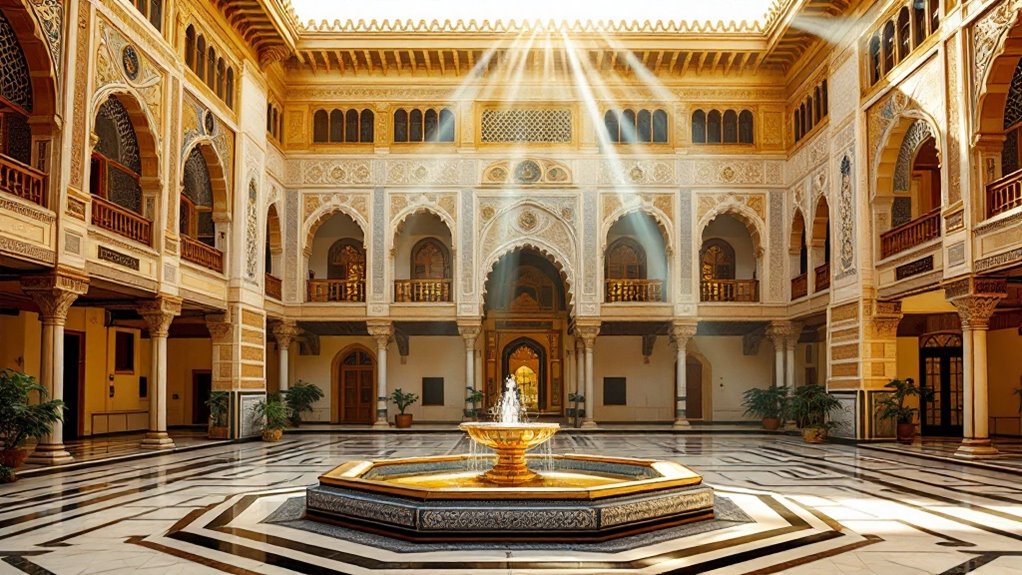
Standing majestically in Damascus's old quarter, the Al Azem Palace captures the epitome of Ottoman-era splendor with its striking blend of architectural styles.
You'll step into a masterpiece of 18th-century craftsmanship, where 800 skilled workers spent three years creating this architectural marvel using repurposed materials from ancient structures.
When you visit, you'll discover three remarkable features that make this palace unforgettable:
Today, you can explore this former governor's residence turned museum, where each room tells stories of Syria's rich cultural heritage and Ottoman influence. The palace houses an impressive collection of Syrian traditional costumes and folk art displays that bring the region's history to life.
Beyond the grand palaces and ancient monuments, you'll discover the true heart of Syria in its resilient local communities.
You'll meet female construction crews who've rebuilt schools in Idlib, skilled artisans restoring Aleppo's historic souks, and innovative farmers transforming bomb craters into thriving urban gardens.
In community centers across the country, you can witness remarkable initiatives, from master weavers preserving traditional Damascene brocade to beekeepers reintroducing native Syrian bees.
When you visit, you'll have the chance to support local cooperatives producing world-famous Aleppo soap, join archaeological tours led by knowledgeable local guides, and taste authentic Levantine recipes in community kitchens.
These grassroots efforts showcase how Syrians are rebuilding their lives while maintaining their rich cultural heritage. The country's position at the crossroads of Africa, Asia, and Europe has shaped its uniquely diverse cultural landscape that endures today.
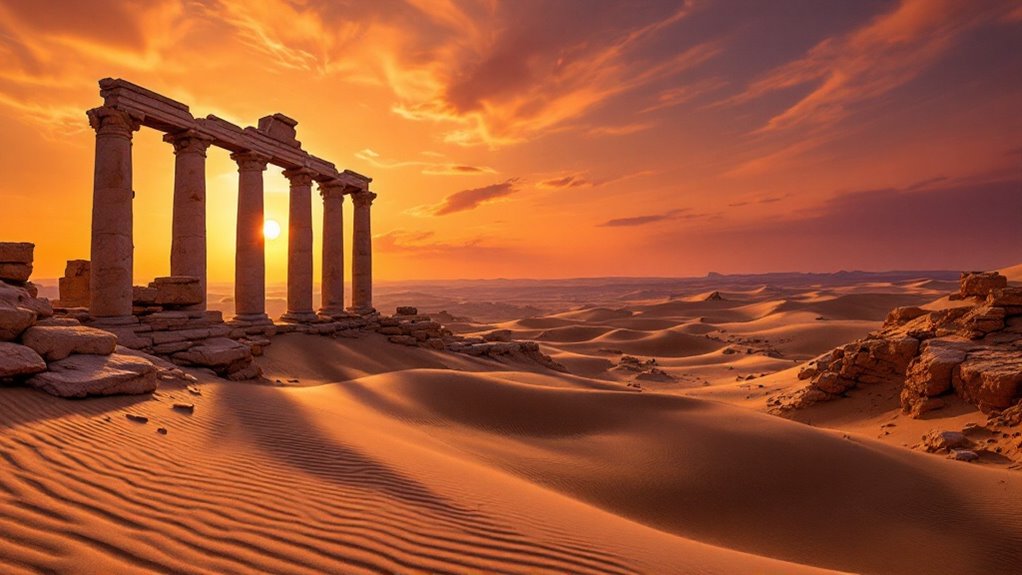
When golden sunlight washes over Palmyra's ancient ruins, you'll witness one of the world's most breathtaking archaeological spectacles. The 2,000-year-old Roman-era structures emerge from the desert landscape, creating stunning contrasts between golden sand dunes and pale limestone columns. Before the war, this spectacular site drew 150,000 monthly visitors seeking to experience its magnificence.
Ancient columns rise from Palmyra's golden sands, where Roman history meets desert majesty in a timeless dance of light and stone.
For the best sunset experience at Palmyra, you'll want to:
The site's minimal modern infrastructure allows unobstructed views of temples and arches, while the desert's natural lighting transforms carved details into a photographer's paradise as day turns to dusk.
You will discover that Syria's treasures shine like diamonds in the rough, waiting to be rediscovered by adventurous souls. While parts of this ancient land still bear the scars of conflict, its resilient spirit and timeless wonders beckon you to explore. From the haunting beauty of Palmyra to the bustling souqs of Damascus, Syria's rich tapestry of history, culture, and humanity offers an unforgettable journey that'll reshape your perspective on this misunderstood corner of the world.